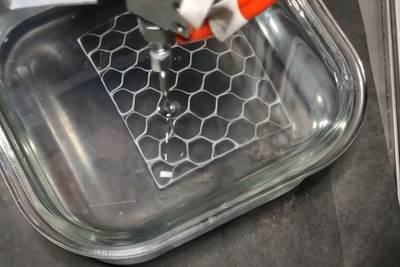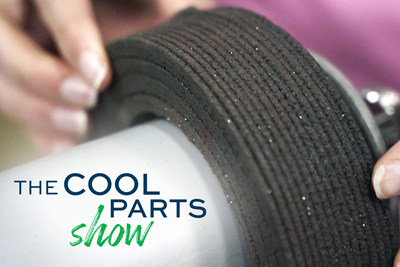6 Ways Additive Manufacturing Will Change in the Next Decade: AM Radio #11B
Where will additive manufacturing go in the next 10 years? Stephanie Hendrixson and Pete Zelinski offer six ideas in the latest episode of the AM Radio podcast.
Share
When stereolithography was invented more than 30 years ago, would anyone have guessed that 3D printing technology would explode, expand and come to change the way that production parts are made? Likely not. Additive Manufacturing Media has reported on industrial uses for 3D printing over the last 10 years, and while some of the issues around AM have remained the same, the techniques, materials and applications have grown exponentially. And we predict that this growth will continue, though perhaps in different directions than it has thus far.
In the most recent edition of the AM Radio podcast, I challenged co-host and AM editor-in-chief Peter Zelinski to come up with some predictions about where additive manufacturing is headed over the next 10 years. We each shared three ideas, summarized below. Read on or listen to the episode (embedded above or anywhere you get your podcasts).
6 Predictions for Additive Manufacturing's Next 10 Years:
- Service parts will lead to a re-engineering of the entire product lifecycle. 3D printing has great potential as a source of aftermarket and spare parts, but only if 3D printable files exist for those parts. In the future, we will rely less on 3D scanning and reverse engineering because those digital files will exist from the beginning, and be created as part of the product’s initial development.
- Increasingly irregular and organic designs. There is some extent to which today’s designers and engineers hold back on using additive manufacturing to its full geometric capability, simply because the consumers and users of 3D printed items must feel a sense of trust and recognition of these objects. As humans become more accustomed to generative designed and topology optimized forms, the door will open to increasingly complex, asymmetric and optimized objects, whether they be aerospace brackets, automotive engine components or consumer products.
- The arrival of a new category of machine shop that specializes in metal AM parts. Additively manufactured parts are unlike the stock, blanks or even castings most machine shops are accustomed to handling. A new class of machine shops staffed and equipped to fixture, locate, machine and inspect the often irregular parts possible through 3D printing is on the horizon.
- More intentional material usage enabled by AM. 3D printing allows for material conservation by encouraging the use of material only where it is necessary, but it also increasingly supports the use of gradients and the joining of different materials. These capabilities will challenge the notion that one part should be made of a single material, and enable more innovative designs and better conservation of high-value materials. Expanding options for sustainable materials from bio-based or recycled sources will also support this material intentionality.
- Inventors as a new category of manufacturers. There is a hard line today between product development and manufacturing, where design and ideation must stop to enable production through injection molding, machining or some other conventional method. Not so with additive manufacturing; without tooling, the design of the product can continue to change even as the item goes into production — and the inventor can continue to be involved, even to be the manufacturer through 3D printing.
- New kinds of 3D printing that we have not yet imagined. The past year alone has revealed a handful of unexpected means of constructing parts layer by layer; there's no telling what the next ten might add to the available options. 3D printing methods that today are only in development, only the seed of an idea or perhaps not even in existence at all could prove to be the next important advance in AM’s next decade.
Related Content
-
How to Build 10,000+ Shot Molds in Hours
Rapid tooling isn’t so rapid when it takes days to 3D print a metal mold, and then you still must machine it to reach the necessary tolerances. With Nexa3D’s polymer process you can print a mold in hours that is prototype or production ready and can last for more than 10,000 shots.
-
Large-Format “Cold” 3D Printing With Polypropylene and Polyethylene
Israeli startup Largix has developed a production solution that can 3D print PP and PE without melting them. Its first test? Custom tanks for chemical storage.
-
How Norsk Titanium Is Scaling Up AM Production — and Employment — in New York State
New opportunities for part production via the company’s forging-like additive process are coming from the aerospace industry as well as a different sector, the semiconductor industry.
Related Content
How to Build 10,000+ Shot Molds in Hours
Rapid tooling isn’t so rapid when it takes days to 3D print a metal mold, and then you still must machine it to reach the necessary tolerances. With Nexa3D’s polymer process you can print a mold in hours that is prototype or production ready and can last for more than 10,000 shots.
Read MoreLarge-Format “Cold” 3D Printing With Polypropylene and Polyethylene
Israeli startup Largix has developed a production solution that can 3D print PP and PE without melting them. Its first test? Custom tanks for chemical storage.
Read MoreHow Norsk Titanium Is Scaling Up AM Production — and Employment — in New York State
New opportunities for part production via the company’s forging-like additive process are coming from the aerospace industry as well as a different sector, the semiconductor industry.
Read More3D Printing with Plastic Pellets – What You Need to Know
A few 3D printers today are capable of working directly with resin pellets for feedstock. That brings extreme flexibility in material options, but also requires greater knowledge of how to best process any given resin. Here’s how FGF machine maker JuggerBot 3D addresses both the printing technology and the process know-how.
Read MoreRead Next
Our 10 Year Anniversary! We Note Changes, Revisit Leading Stories
This month marks the 10-year anniversary of Additive Manufacturing Media. We return to find new stories at companies we have covered in the past, and we take stock of how dramatically AM has advanced in the span of just one decade.
Read MoreIs a Gel Bath the Key to Scalable, Affordable 3D Printed Ceramics?
3D printed polymer-derived ceramics (PDCs) could find wider application through a process developed at the University of Texas at Dallas that extrudes preceramic material in a self-healing bath for support through printing and curing.
Read More3D Printed Magnets: The Cool Parts Show #38
Is it possible to 3D print a magnet? In this episode of The Cool Parts Show, we learn how magnets have been printed successfully at Oak Ridge National Lab, and the implications this has for energy, material conservation and supply chains.
Read More
.jpg;width=70;height=70;mode=crop)



.png;maxWidth=300;quality=90)












